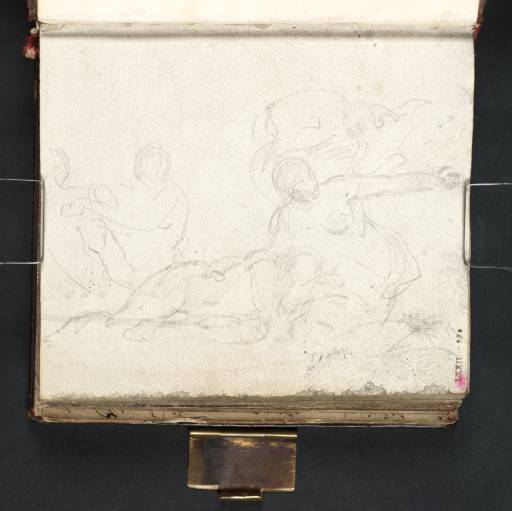Joseph Mallord William Turner Three Figures, after Francesco Primaticcio 1802
Joseph Mallord William Turner,
Three Figures, after Francesco Primaticcio
1802
Joseph Mallord William Turner 1775–1851
Folio 88 Verso:
Three Figures, after Francesco Primaticcio 1802
D04388
Turner Bequest LXXII 88a
Turner Bequest LXXII 88a
Pencil on white wove paper prepared with a grey wash, 114 x 128 mm
Stamped in black ‘LXXII–88a’ bottom right, ascending vertically
Stamped in black ‘LXXII–88a’ bottom right, ascending vertically
Accepted by the nation as part of the Turner Bequest 1856
References
1909
A.J. Finberg, A Complete Inventory of the Drawings of the Turner Bequest, London 1909, vol.I, p.193, LXXII 88a, as ‘three figures; one lying down with a female figure bending over it pointing with left arm, behind them a seated figure of a young man’.
1993
Jean-Pierre Cuzin and Marie-Anne Dupuy, Copier créer. De Turner à Picasso: 300 oeuvres inspirées par les maîtres du Louvre, exhibition catalogue, Musée du Louvre, Paris 1993, p.80, as unidentified.
Turner turned the sketchbook to landscape format to make this drawing. Hitherto unidentified, its source has recently been traced to Francesco Primaticcio (1504–70) by Vincent Delieuvin,1 who cites especially a small ink and wash drawing2 from the former French royal collection that was included in a display of drawings in the Louvre’s Galerie d’Apollon in 1802. This was one of a series of exhibitions of drawings organised mainly by Morel d’Arleux, curator of prints and drawings since 1797.3 If Turner’s drawing was made from this sheet, it is the only evidence of his having looked at master drawings as well as paintings in 1802. However, his observation is sketchy and lacks the detail of Primaticcio’s drawing, concentrating on outlines of the central, reclining figure and others but excluding the surrounding horses, sea and rays of light. The possibility must also be considered that Turner visited Fontainebleau, the former royal hunting lodge outside Paris, and worked from the painted version of the composition on the ceiling of the vestibule of the Porte Dorée of the palace. He certainly passed near Fontainebleau and through the surrounding forest on his way south towards the Alps in 1802. The poor condition of the fresco at this time may have accounted for the relative vagueness of Turner’s drawing.
Primaticcio executed cycles of painted decorations in the Mannerist style at Fontainebleau from 1532, taking over as chief painter there on the death of Rosso Fiorentino in 1540. The Porte Dorée was designed by Gilles le Breton, 1528–40, in the style of a triumphal arch as the south entrance to the palace’s Cour Ovale.
The subject of this composition by Primaticcio has been disputed. In the Notices des dessins for the 1802 display it was entitled ‘Marine Gods drawing the Horses of the Sun (‘Divinités marines amenant les chevaux du Soleil’)4 but it had attracted other interpretations before and has done since, the most recent being Night protecting sleeping Time from the Sun, Aurora (Dawn) awakening Sleep5 or Saturn sleeping among Tritons.6
David Blayney Brown
September 2008
Thanks are due to Vincent Delieuvin and his colleague Guillaume Faroult, both of the Département des Peintures, Musée du Louvre; email from the latter to Ian Warrell, 28 August 2008.
Lina Propeck in Pierre Rosenberg and Marie-Anne Dupuy, Dominique-Vivant Denon: l’oeil de Napoléon, exhibition catalogue, Musée du Louvre, Paris 1999, pp.211, 214.
Notices des dessins originaux, esquisses peintes, cartons, gouaches, pastels, émaux et miniatures du Musée central des Arts. Exposés pour la première fois, dans la Galerie d’Apollon, en messidor de l’an X, Paris 1802, no.217.
How to cite
David Blayney Brown, ‘Three Figures, after Francesco Primaticcio 1802 by Joseph Mallord William Turner’, catalogue entry, September 2008, in David Blayney Brown (ed.), J.M.W. Turner: Sketchbooks, Drawings and Watercolours, Tate Research Publication, December 2012, https://www

